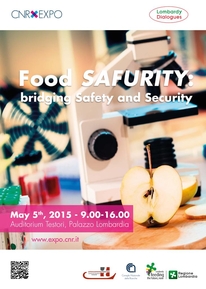Lombardy Dialogues: Food safurity: bridging safety and security

Coordinator: Marcella Chiari
Institute of Chemistry of Molecular Recognition (ICRM)
INTERVIEW TO MARCELLA CHIARI
What kind of event is that one organized for EXPO?
It is one of the three 'Lombardy Dialogues', organized by the National Research Council in collaboration with Unioncamere and Lombardy Region. The goal is to promote and give visibility to the excellence of Lombardy in the field of research and innovation applied to an environmentally sustainable production of food.
This event will focus on systems for food processing, traceability, packaging and logistics, in the context of food safety and security. Actually the two terms have been merged together in the new word Safurity that aims to emphasize the area of reciprocal overlapping. After the conference, a bus for visiting Yomo, a major dairy industry, has been organized.
How can one ensure food security?
As suggested by the title of the conference, security is better defined by its combination with safety. Therefore on one side you must check food for potential risk factors such as pathogens, toxins, toxic elements such as lead, cadmium, mercury and on the other you must work to increase the amount and prolong the durability and shelf-life of the food products
Why is sustainability so important?
Because the challenge is to meet the increasing demand on safe food by introducing novelties in the food supply chain that make processing, packaging , distribution more efficient and environmentally friendly.
How will the food industry of the future be?
Many technological and procedural novelties will be imported by the manufacturing sector that is highly developed in Italy. Thus, robotic devises will increase efficiency, precision, repeatability and safety of the operations. Additive manufacturing, substantially based on 3D printing, will effectively address processing problems and provide the tools for custom-printed food. All a bunch of new technologies capable of monitoring and adapt in a flexible manner to many variables such as climate, location, different agricultural and animal products will be introduced. Virtual reality will also have a role in the training of operators when manual skill is requested as well as the layout design of area with special hygienic conditions.
In the future we can have some real factories of food, which will take from manufacturing certain technologies and procedures such as robotics and intelligent systems of recognition. They will make a sort of food manifacture. In theory we could already be able to lyophilize the various ingredients and then use those powders as 'ink' of a 3D printer, capable of printing various types of foods, including for example a steak. I personally don't like this scenario and I do not think it will be explored further. I am in favour of using advanced and sophisticated techniques, which reduce the presence of pathogens and preservatives, for the preparation of food. Obviously also the starting materials must be fresh and of good quality. About steaks, therefore it will be probably easier that in future one can cut the slices of meat with a robot, able to cut all the way he wants. Or one can list and automatically weigh the ingredients of a certain preparation, or add spices and salt in an automated way. In part these technologies already exist, but in the future an increasing number of technologies will be transfered from manufacturing to agrofood.
What kind of technology transfer will affect the agro-industrial sector?
An increasing number of components of food products will be controlled to ensure their quality and safety to the consumer. This will increase the amount of information to such an extent that paper labels will be inadequate . Therefore the future will have to rely on cloud infrastructures, accessible via smartphone or computer through which the consumer will recover the desired level of information in detail This will eventually replace the confidence typically experienced with proximity suppliers.
Who will produce all of this information?
The manufacturer and supplier of raw materials in the production chain, but also a series of sensors developed ad hoc.
What are the characteristics of these sensors?
They are electronic devices, applied in different contexts. They are able to detect the presence of molds or bacterial contaminants, and in case inform the consumer or give the alarm. The sensors can be online or offline, and the idea is to use them even at very low levels in the chain. For now, typical supermarkets have no way to verify the information that is given by the producer of a certain product but the availability of disposable, lab-on-chip type of sensors could bring the consumer closer to the verification of the data.
Where will the sensors be used?
For example, they could be placed in the fridge, or in the oven. Supermarkets are very careful as to ensure the safe transport and storage from farm to shelf. The real problems, however, could start in the refrigerator. There we do not keep under control potential toxic agents that grow in foods.
Production, characterization, labeling ... what will happen in the world of distribution?
As we know today the distribution of goods is done in logistic units with substantial volumes, configured to accommodate different products at the same time (which travel with an average coverage of 47%). Individual logistic units, made "smart" by on board refrigeration and air conditioning technologies, are under development. They should be able to ensure the best conditions during the transport, to the benefit of small-scale production of quality, and, at the same time, integrate themselves in intermodal logistics, with clear benefits for the environmental sustainability.
IN COLLABORATION WITH:
Confagricoltura
Università degli Studi di Brescia
Università degli Studi di Milano
City University of London
Istituto Zooprofilattico Sperimentale della Lombardia e dell'Emilia Romagna
Consiglio per la Ricerca e la Sperimentazione in Agricoltura
Parco Tecnologico Padano
Zaragoza Logistics Center
Tecnoalimenti Srl
Metalvuoto Spa
Versalis
Istituto di Chimica del Riconoscimento Molecolare
Istituto di Tecnologie Industriali ed Automazione
Istituto per lo Studio delle Macromolecole
Politecnico di Milano
IFN, Istituto di Fotonica e Nanotecnologie - CNR
Università Carlo Cattaneo - LIUC



